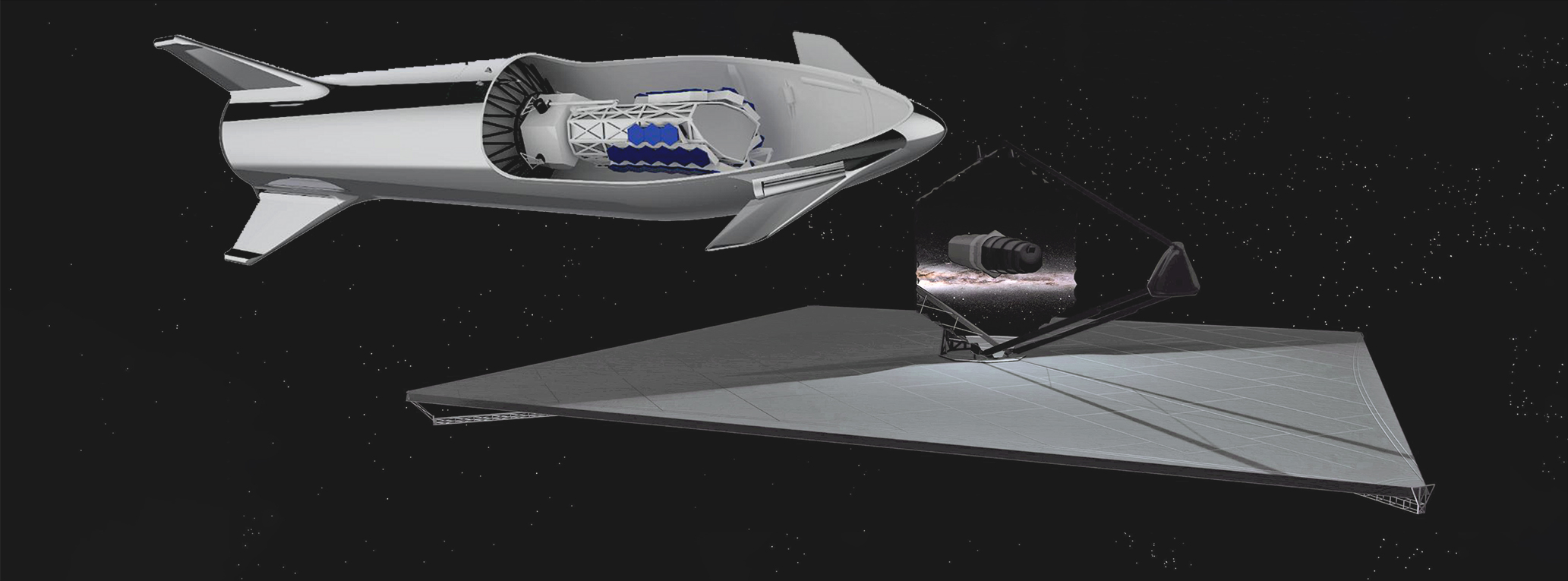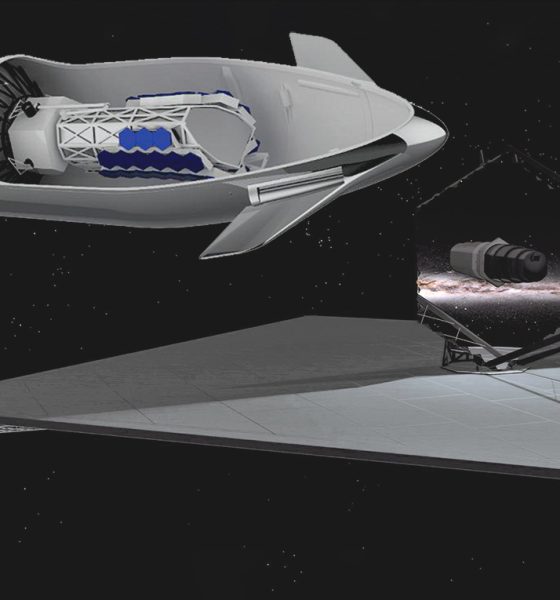

SpaceX
SpaceX’s steel Starship gets new official render, this time with a huge NASA telescope
SpaceX recently provided NASA with the third known official render of its stainless steel Starship, focused on the vehicle’s potential utility for launching massive scientific spacecraft for NASA. Starship’s only direct competition for the proposed LUVOIR telescope: NASA’s own SLS rocket.
Published by NASA’s Goddard Space Flight Center (GSFC), Starship is shown with a smaller “B” variant of the proposed LUVOIR space telescope in its payload bay. According to a scientist from the Space Telescope Science Institute (STSI), the massive LUVOIR-A variant could “barely” fit inside Starship’s clamshell bay, but the telescope could also be tweaked to more perfectly fit the constraints of its chosen launch vehicle. LUVOIR is effectively being designed as a logical follow-up to the James Webb Space Telescope (JWST) and could be ready to launch no earlier than 2039 if NASA selects the idea – one of three under consideration – for future development.
The LUVOIR telescope (shorthand for Large UV/Optical/IR Surveyor) is currently grouped into two different categories, A and B. A is a full-scale, uncompromised telescope with a vast 15-meter primary mirror and a sunshade with an area anywhere from 5000 to 20000 square meters (1-4 acres). B is a smaller take on the broadband surveyor telescope, with an 8-meter primary mirror (a quarter of the area of LUVOIR-A’s) accompanied by a similarly reduced sunshade (and price tag, presumably).
— Teslarati, July 2018
Goddard’s “we asked, SpaceX checked” statement refers to a funded analysis of LUVOIR launch options the group announced back in July 2018, at which point the future prospects of NASA’s SLS rocket were far more stable. Approximately nine months later, NASA administrator Jim Bridenstine announced that all work on future SLS upgrades – including the Block 1B and Block 2 variants that could have supported the launch of LUVOIR-A – was to be halted as soon as possible. All of that funding would instead be focused on mitigating a never-ending string of delays and pushing SLS to actually prepare for its first launches. Bridenstine has since publicly waffled on that aggressive plan, simultaneously indicating that some of those SLS upgrades (mainly an advanced upper stage, EUS) would be critical for one variant of his proposal to return astronauts to the Moon as early as 2024.
Regardless, the blood of SLS is currently in the water as NASA pursues an answer to the question of whether commercial rockets can instead be used to launch the agency’s Orion spacecraft and Lunar Gateway segments. Based on preliminary interviews focused on NASA’s internal study of the subject, there is still plenty of room for SLS as long as its contractors (namely Boeing) can stem relentless delays, cost overruns, and quality control issues and finally prepare the rocket for its first missions.
As described above, it appears likely that NASA is going to require the SLS rocket’s core stage to conduct a critical mission-duration test fire before permitting the vehicle to begin launch preparations in Florida. As a result, there will be almost no conceivable way for the rocket to rise to the 2020 launch debut challenge issued by Bridenstine, potentially meaning that NASA will put significant resources into studying and developing alternatives to SLS. If or when NASA sets the precedent for allowing serious studies and funding of SLS alternatives, the death of the rocket will almost certainly be assured. Relative to commercial rockets like Falcon Heavy, New Glenn, Vulcan Heavy, and even SpaceX’s BFR (i.e. Starship/Super Heavy), conservative estimates suggest that SLS will be no less than 5-20+ times as expensive on a per-launch basis.
Consequently, it should come as no surprise to see NASA Goddard openly confirm its willingness to launch future flagship science missions on SpaceX’s Starship vehicle, so long as the rocket is successfully developed, launched, and certified by NASA for high-value missions. Given just how distant the proposed ~2039 launch of LUVOIR is and how early SpaceX is in the process of developing Starship/Super Heavy into a highly mature and reliable launch vehicle, one should not read too far into Goddard’s public support.
However, there should be no doubt at this point that SpaceX’s next-generation Starship and current-generation Falcon Heavy rockets are already upsetting certain aspects of the status quo. If SpaceX continues to refine Starship’s design and demonstrate Falcon Heavy’s reliability and readiness, studies like Goddard’s LUVOIR launch case can be expected to crop up throughout domestic and global space industries, both pubic and private.
Check out Teslarati’s Marketplace! We offer Tesla accessories, including for the Tesla Cybertruck and Tesla Model 3.

Elon Musk
Elon Musk’s Biggest Revelations on AI, Robots, and the Future of Work from the Moonshots Podcast

Elon Musk’s appearance on the Moonshots with Peter Diamandis podcast was packed with bold predictions, candid admissions, and surprising tech insights. The nearly three-hour conversation covered everything from artificial intelligence to humanoid robots, geopolitics, and the future of work. Here are the top 10 most intriguing takeaways:
-
Aggressive AGI Timeline Predictions
Musk offered a detailed view on when artificial general intelligence (AGI) could emerge, suggesting it may arrive sooner than many expect, emphasizing both transformative potential and risks.
-
U.S. vs. China in the AI Race
He discussed the strategic competition between the United States and China over AI development, noting that geopolitical dynamics will shape how and who leads in the next decades.
-
Future of Job Markets
Musk touched on how AI and automation could reshape employment, predicting massive boosts in productivity alongside potential disruptions in traditional work structures.
-
Clean Energy Transition
A recurring theme was the role of clean energy in future economies, with Musk reiterating the importance of scaling sustainable power generation and storage.
-
Humanoid Robots Are Coming
On the podcast, Musk elaborated on Tesla’s work on humanoid robots, hinting at timelines and applications that go beyond factories to general-purpose assistance.
-
Tesla Roadster “Last Human-Driven Car”
Outside the core discussion topics, Musk teased features of the upcoming Tesla Roadster — calling it “the best of the last of the human-driven cars” and suggesting safety won’t be its main selling point.
-
The Role of AI in Clean Energy and Robotics
Linking AI to both energy optimization and robotics, Musk explained how smarter systems could accelerate decarbonization and task automation across industries.
-
U.S. Innovation Leadership
Musk argued that maintaining American leadership in key tech sectors like AI, space, and robotics should be a national priority, with thoughtful policy and investment.
-
Job Creation vs. Job Elimination
While acknowledging automation’s disruptive effects, he also outlined scenarios where new industries and opportunities could emerge, particularly in AI, space, and advanced manufacturing.
-
Long-Term Vision for Humanity
Throughout the conversation, Musk revisited his long-term philosophical views — including a belief in humanity’s responsibility to become a multi-planetary and technologically empowered species.
Whether you agree with Musk’s optimism or not, the podcast offers a window into the thinking of one of the most influential figures in tech today, in and why his visions continue to spark debate and inspiration.
Elon Musk
Starlink achieves major milestones in 2025 progress report
Starlink wrapped up 2025 with impressive growth, adding more than 4.6 million new active customers and expanding service to 35 additional countries, territories, and markets.

Starlink wrapped up 2025 with impressive growth, adding more than 4.6 million new active customers and expanding service to 35 additional countries, territories, and markets. The company also completed deployment of its first-generation Direct to Cell constellation, launching over 650 satellites in just 18 months to enable cellular connectivity.
SpaceX highlighted Starlink’s impressive 2025 progress in an extensive report.
Key achievements from Starlink’s 2025 Progress
Starlink connected over 4.6 million new customers with high-speed internet while bringing service to 35 more regions worldwide in 2025. Starlink is now connecting 9.2 million people worldwide. The service achieved this just weeks after hitting its 8 million customer milestone.
Starlink is now available in 155 markets, including areas that are unreachable by traditional ISPs. As per SpaceX, Starlink has also provided over 21 million airline passengers and 20 million cruise passengers with reliable high-speed internet connectivity during their travels.
Starlink Direct to Cell
Starlink’s Direct to Cell constellation, more than 650 satellites strong, has already connected over 12 million people at least once, marking a breakthrough in global mobile coverage.
Starlink Direct to Cell is currently rolled out to 22 countries and 6 continents, with over 6 million monthly customers. Starlink Direct to Cell also has 27 MNO partners to date.
“This year, SpaceX completed deployment of the first generation of the Starlink Direct to Cell constellation, with more than 650 satellites launched to low-Earth orbit in just 18 months. Starlink Direct to Cell has connected more than 12 million people, and counting, at least once, providing life-saving connectivity when people need it most,” SpaceX wrote.
Elon Musk
Starlink passes 9 million active customers just weeks after hitting 8 million
The milestone highlights the accelerating growth of Starlink, which has now been adding over 20,000 new users per day.

SpaceX’s Starlink satellite internet service has continued its rapid global expansion, surpassing 9 million active customers just weeks after crossing the 8 million mark.
The milestone highlights the accelerating growth of Starlink, which has now been adding over 20,000 new users per day.
9 million customers
In a post on X, SpaceX stated that Starlink now serves over 9 million active users across 155 countries, territories, and markets. The company reached 8 million customers in early November, meaning it added roughly 1 million subscribers in under seven weeks, or about 21,275 new users on average per day.
“Starlink is connecting more than 9M active customers with high-speed internet across 155 countries, territories, and many other markets,” Starlink wrote in a post on its official X account. SpaceX President Gwynne Shotwell also celebrated the milestone on X. “A huge thank you to all of our customers and congrats to the Starlink team for such an incredible product,” she wrote.
That growth rate reflects both rising demand for broadband in underserved regions and Starlink’s expanding satellite constellation, which now includes more than 9,000 low-Earth-orbit satellites designed to deliver high-speed, low-latency internet worldwide.
Starlink’s momentum
Starlink’s momentum has been building up. SpaceX reported 4.6 million Starlink customers in December 2024, followed by 7 million by August 2025, and 8 million customers in November. Independent data also suggests Starlink usage is rising sharply, with Cloudflare reporting that global web traffic from Starlink users more than doubled in 2025, as noted in an Insider report.
Starlink’s momentum is increasingly tied to SpaceX’s broader financial outlook. Elon Musk has said the satellite network is “by far” the company’s largest revenue driver, and reports suggest SpaceX may be positioning itself for an initial public offering as soon as next year, with valuations estimated as high as $1.5 trillion. Musk has also suggested in the past that Starlink could have its own IPO in the future.








